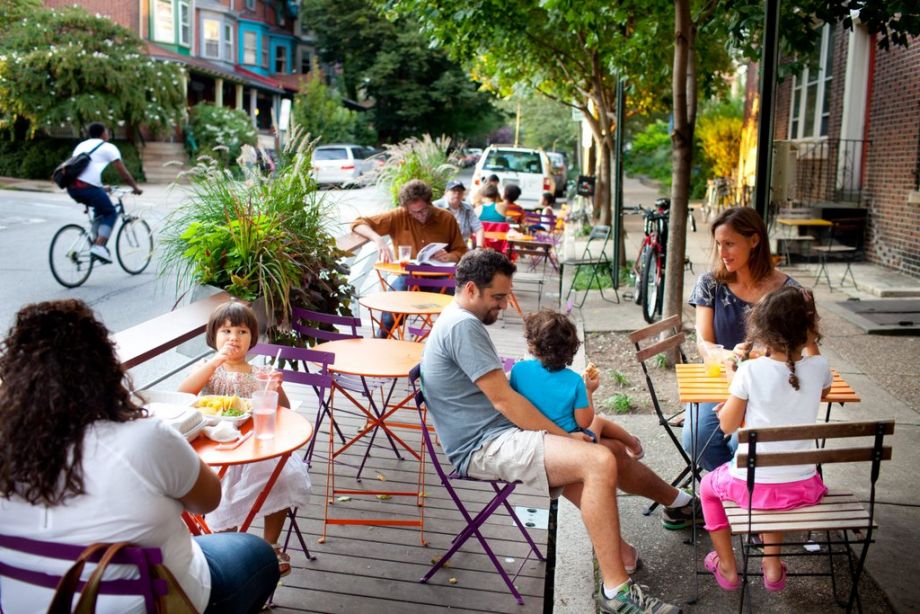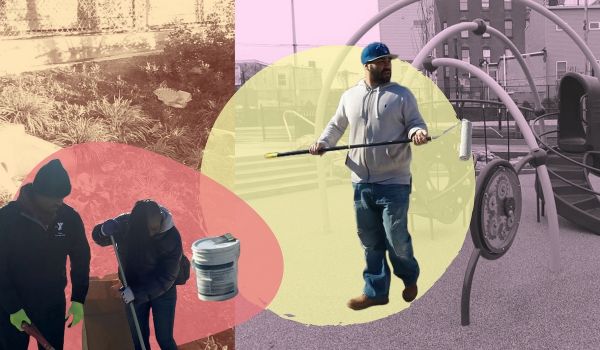Since 2010, over 180 parklets have appeared nationwide. Pretty much wherever they pop up, people love these small platforms that take up one or two parking spaces, and provide space for people to park their keesters instead of their cars. Beloved they are, but easy they aren’t. It takes time, money and effort to keep parklets clean and inviting — and in many urban neighborhoods, all three of these resources are in tight supply. Given that, it’s no surprise that 75 percent of parklets nationwide are built and operated primarily by private businesses and most are located on busy commercial districts, not the underinvested neighborhoods most in need of welcoming public space. Yet in Philadelphia, where I work as an urban planner for the city, a different approach has taken hold. This approach offers lessons to other cities seeking to create more inviting public spaces in neighborhoods that are short on them.
Unlike the conventional model, Philadelphia’s parklets are driven by the city’s nonprofit sector, with 75 percent of the spaces sponsored by a nonprofit that works with neighborhood organizations, city government and “operators,” which are small businesses that host and maintain this pocket park on the street. The nonprofit sponsors play a key role in getting the right permits and managing the design process while the operators manage the day-to-day life of the space. It may sound like a lot of cooks for such a tiny kitchen, but I learned differently through a study conducted with co-authors who managed the parklets both from the city and nonprofit sector.
What we found is that Philadelphia’s parklet sponsors tend to be stronger than your average nonprofit and that strength matters to the success of their parklet. Parklet sponsors tended to bring in nearly five times as much in revenue as control groups and reported spending close to 15 times more on placemaking activities, and nearly six times as much on economic development. Parklet Sponsors also spent on average nearly twice as much per employee. Other research supports our findings. A 2013 study by Los Angeles urban planner Gary Benjamin found that business improvement district organizations managing New York’s pedestrian plazas averaged a $4.7 million budget, nearly three and a half times the size of the average NYC BID not managing a pedestrian plaza. In San Francisco, the BIDs managing pedestrian plazas averaged a $1.5 million budget, nearly one and a half time times the size of the average BID not managing a pedestrian plaza.
Money isn’t the only resource needed to make for a successful parklet. Our research showed that while nonprofit sponsors had virtually all accessed a variety of the economic development resources provided by the city, virtually none of the businesses that maintained parklets, control or otherwise had done so. Similarly, nonprofit sponsors and their control counterparts were far more likely to report positive relations with their district councilperson than small business parklet operators and their percent control counterparts. This difference is indicative of a gap between City Hall and main street that is difficult to bridge without nonprofit civic intermediaries who can broker conversations between community and the city.
Philadelphia Mayor Jim Kenney has taken on the revitalization of commercial corridors as part of his strategy for neighborhood growth. What we found through our study of parklets is that when it comes to sustaining public space improvements, the social infrastructure is just as important as the physical. You can build all the tables you want, but if no one is there and able to talk across them, what is the gain?
Ariel Ben Amos is an urban planner, Philly flaneur and proud papa. He is the co-author of “Park(let) Here: Organizational and Demographic Preconditions for the Development of Parklets in Philadelphia” with Charlotte Castle, Transportation Systems Program Planner for the Office of Transportation and Infrastructure Systems, Cara Ferrentino, Program Officer for Public Space with William Penn Foundation,T. Andrew Simpson, Candidate for MCP 2018, Daniel Wolf, Neighborhood Planner at the City of Cambridge, Massachussetts.
















